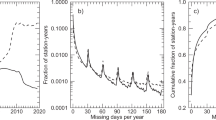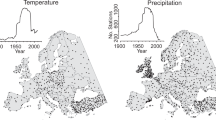Abstract
Epidemiologic analyses of the health effects of meteorological exposures typically rely on observations from the nearest weather station to assess exposure for geographically diverse populations. Gridded climate datasets (GCD) provide spatially resolved weather data that may offer improved exposure estimates, but have not been systematically validated for use in epidemiologic evaluations. As a validation, we linearly regressed daily weather estimates from two GCDs, PRISM and Daymet, to observations from a sample of weather stations across the conterminous United States and compared spatially resolved, population-weighted county average temperatures and heat indices from PRISM to single-pixel PRISM values at the weather stations to identify differences. We found that both Daymet and PRISM accurately estimate ambient temperature and mean heat index at sampled weather stations, but PRISM outperforms Daymet for assessments of humidity and maximum daily heat index. Moreover, spatially-resolved exposure estimates differ from point-based assessments, but with substantial inter-county heterogeneity. We conclude that GCDs offer a potentially useful approach to exposure assessment of meteorological variables that may, in some locations, reduce exposure measurement error, as well as permit assessment of populations distributed far from weather stations.
This is a preview of subscription content, access via your institution
Access options
Subscribe to this journal
Receive 6 print issues and online access
$259.00 per year
only $43.17 per issue
Buy this article
- Purchase on Springer Link
- Instant access to full article PDF
Prices may be subject to local taxes which are calculated during checkout



Similar content being viewed by others
References
Anderson GB, Bell ML. Heat waves in the United States: mortality risk during heat waves and effect modification by heat wave characteristics in 43 U.S. communities. Environ Health Persp. 2011;119:210–8.
Bobb JF, Peng RD, Bell ML, Dominici F. Heat-related mortality and adaptation to heat in the United States. Environ Health Persp. 2014;122:811–6.
Gasparrini A, Guo YM, Hashizume M, Kinney PL, Petkova EP, Lavigne E, et al. Temporal variation in heat-mortality associations: a multicountry study. Environ Health Persp. 2015;123:1200–7.
Knowlton K, Rotkin-Ellman M, King G, Margolis HG, Smith D, Solomon G, et al. The 2006 California heat wave: impacts on hospitalizations and emergency department visits. Environ Health Persp. 2009;117:61–7.
Medina-Ramon M, Schwartz J. Temperature, temperature extremes, and mortality: a study of acclimatisation and effect modification in 50 US cities. Occup Environ Med. 2007;64:827–33.
Bobb JF, Obermeyer Z, Wang Y, Dominici F. Cause-specific risk of hospital admission related to extreme heat in older adults. J Am Med Assoc. 2014;312:2659–67.
Buckley JP, Richardson DB. Seasonal modification of the association between temperature and adult emergency department visits for asthma: a case-crossover study. Environ Health. 2012;11:55.
Hansel NN, McCormack MC, Kim V. The effects of air pollution and temperature on COPD. COPD. 2016;13:372–9.
Kingsley SL, Eliot MN, Gold J, Vanderslice RR, Wellenius GA. Current and projected heat-related morbidity and mortality in Rhode Island. Environ Health Persp. 2016;124:460–7.
Anderson GB, Bell ML, Peng RD. Methods to calculate the heat index as an exposure metric in environmental health research. Environ Health Persp. 2013;121:1111–9.
Metzger KB, Ito K, Matte TD. Summer heat and mortality in New York City: how hot is too hot? Environ Health Persp. 2010;118:80–6.
Wellenius GA, Eliot MN, Bush KF, Holt D, Lincoln RA, Smith AE, et al. Heat-related morbidity and mortality in New England: Evidence for local policy. Environ Res. 2017;156:845–53.
Barreca AI, Shimshack JP. Absolute humidity, temperature, and influenza mortality: 30 years of county-level evidence from the United States. Am J Epidemiol. 2012;176:S114–22.
Jaakkola K, Saukkoriipi A, Jokelainen J, Juvonen R, Kauppila J, Vainio O, et al. Decline in temperature and humidity increases the occurrence of influenza in cold climate. Environ Health 2014;13:22.
Menne MJ, Durre I, Vose RS, Gleason BE, Houston TG. An overview of the Global Historical Climatology Network-Daily database. J Atmos Ocean Tech. 2012;29:897–910.
Lee M, Shi L, Zanobetti A, Schwartz JD. Study on the association between ambient temperature and mortality using spatially resolved exposure data. Environ Res. 2016;151:610–7.
Bornstein R. Observations of the urban heat island effect in New York City. J Appl Meteorol Clim. 1968;7:575–82.
Laaidi K, Zeghnoun A, Dousset B, Bretin P, Vandentorren S, Giraudet E, et al. The impact of heat islands on mortality in Paris during the August 2003 heat wave. Environ Health Persp. 2012;120:254–9.
Keane RE, Holsinger LM, Parsons RA, Gray K. Climate change effects on historical range and variability of two large landscapes in western Montana, USA. For Ecol Manag. 2008;254:375–89.
Neupane RP, Kumar S. Estimating the effects of potential climate and land use changes on hydrologic processes of a large agriculture dominated watershed. J Hydrol. 2015;529:418–29.
Zhao L, Lee X, Smith RB, Oleson K. Strong contributions of local background climate to urban heat islands. Nature. 2014;511:216–9.
Thornton PE, Running SW, White MA. Generating surfaces of daily meteorological variables over large regions of complex terrain. J Hydrol. 1997;190:214–51.
Daly C, Halbleib M, Smith JI, Gibson WP, Doggett MK, Taylor GH, et al. Physiographically sensitive mapping of climatological temperature and precipitation across the conterminous United States. Int J Climatol. 2008;28:2031–64.
Daly C, Smith JI, Olson KV. Mapping atmospheric moisture climatologies across the conterminous United States. Plos ONE 2015;10:e0141140. https://doi.org/10.1371/journal.pone.0141140.
PRISM Climate Group. Parameter-elevation Relationships on Independent Slopes Model (PRISM). Corvallis, Oregon: Northwest Alliance for Computational Science and Engineering at Oregon State University; 2017.
Thornton PE, Thornton MM, Mayer BW, Wei Y, Devarakonda R, Vose RS, et al. Daymet: daily surface weather data on a 1-km grid for North America, version 3. Oak Ridge National Laboratory Distributed Active Archive Center; 2017.
Smith A, Lott N, Vose R. The integrated surface database recent developments and partnerships. B Am Meteorol Soc. 2011;92:704–8.
NOAA. Historical Observing Metadata Repository. U.S. National Oceanic and Atmospheric Administration; n.d. https://www.ncdc.noaa.gov/homr/. Access 28 February 2018.
Diamond HJ, Karl TR, Palecki MA, Baker CB, Bell JE, Leeper RD, et al. U.S. Climate Reference Network after one decade of operations status and assessment. B Am Meteorol Soc. 2013;94:485–98.
Bell JE, Palecki MA, Baker CB, Collins WG, Lawrimore JH, Leeper RD, et al. U.S. Climate Reference Network soil moisture and temperature observations. J Hydrometeorol. 2013;14:977–88.
Kottek M, Grieser J, Beck C, Rudolf B, Rubel F. World map of the Köppen-Geiger climate classification updated. Meteorol Z. 2006;15:259–63.
ORNL. Spatial Data Access Tool (SDAT). Oak Ridge National Laboratory Distributed Active Archive Center; 2017. https://doi.org/10.3334/ORNLDAAC/1388. Access 10 July 2017.
ORNL. World map of the Koppen-Geiger climate classification. Oak Ridge National Laboratory Distributed Active Archive Center; 2017. https://webmap.ornl.gov/ogcdown/dataset.jsp?dg_id=10012_1. Access 10 July 2017.
Højsgaard S, Halekoh U. doBy: Groupwise Statistics, LSmeans, Linear Contrasts, Utilities; 2018. https://CRAN.R-project.org/package=doBy.
U.S. Census Bureau. Centers of population for Census 2000; 2015. https://www.census.gov/geo/reference/centersofpop2000.html. Access 1 December 2017.
Davis RE, McGregor GR, Enfield KB. Humidity: a review and primer on atmospheric moisture and human health. Environ Res. 2016;144:106–16.
Lumley T, Diehr S, Emerson S, Chen L. The importance of the normality assumption in large public health data sets. Annu Rev Public Health. 2002;23:151–69.
Gasparrini A, Armstrong B, Kenward MG. Distributed lag non-linear models. Stat Med. 2010;29:2224–34.
Gasparrini A, Guo YM, Hashizume M, Lavigne E, Zanobetti A, Schwartz J, et al. Mortality risk attributable to high and low ambient temperature: a multicountry observational study. Lancet. 2015;386:369–75.
Core Team R. R: A language and environment for statistical computing. Vienna, Austria: R Foundation for Statistical Computing; 2017.
McEvoy DJ, Mejia JF, Huntington JL. Use of an observation network in the Great Basin to evaluate gridded climate data. J Hydrometeorol. 2014;15:1913–31.
Fischer EM, Knutti R. Robust projections of combined humidity and temperature extremes. Nat Clim Change. 2013;3:126–30.
Guo Y, Barnett AG, Tong S. Spatiotemporal model or time series model for assessing city-wide temperature effects on mortality? Environ Res. 2013;120:55–62.
Daly C. Guidelines for assessing the suitability of spatial climate data sets. Int J Climatol. 2006;26:707–21.
Acknowledgements
Part of this research was conducted using computational resources and services at the Center for Computation and Visualization, Brown University. This work was financially supported in part by the Open Graduate Education and Brown-MBL Programs from the Graduate School of Brown University, and by the Institute at Brown for Environment and Society. Dr. KW was supported by National Institute of Environmental Health Sciences grant F32 ES027742. The content of this report is the responsibility of the authors and does not necessarily represent the official views of the sponsoring institutions.
Author information
Authors and Affiliations
Corresponding author
Ethics declarations
Conflict of interest
The authors declare that they have no conflict of interest.
Supplementary Information
Rights and permissions
About this article
Cite this article
Spangler, K.R., Weinberger, K.R. & Wellenius, G.A. Suitability of gridded climate datasets for use in environmental epidemiology. J Expo Sci Environ Epidemiol 29, 777–789 (2019). https://doi.org/10.1038/s41370-018-0105-2
Received:
Revised:
Accepted:
Published:
Issue Date:
DOI: https://doi.org/10.1038/s41370-018-0105-2
Keywords:
This article is cited by
-
Hourly values of an advanced human-biometeorological index for diverse populations from 1991 to 2020 in Greece
Scientific Data (2024)
-
Identification and characterization of global compound heat wave: comparison from four datasets of ERA5, Berkeley Earth, CHIRTS and CPC
Climate Dynamics (2024)
-
Acute association between heatwaves and stillbirth in six US states
Environmental Health (2022)
-
Wet-Bulb Globe Temperature, Universal Thermal Climate Index, and Other Heat Metrics for US Counties, 2000–2020
Scientific Data (2022)
-
Comparison of weather station and climate reanalysis data for modelling temperature-related mortality
Scientific Reports (2022)



